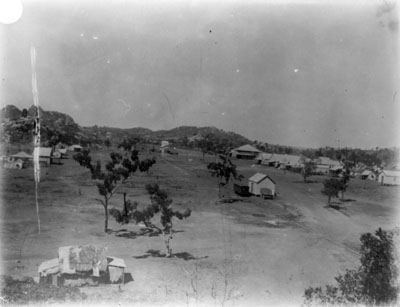|
Mungana Township and Girofla Mine visit 30 September 2001 |
|
| On 30/9/2001 as part of my current University
course I and my fellow students traveled to the long dead township of
Mungana in order to be taught how to conduct a basic site survey.
You have probably never heard of Mungana, however it is famous more of the political intrigue surrounding it than for any economic success. In fact Mungana ended the political career of "Red Ted" Theodore, one time Premier of Queensland and later Federal Treasurer. For the full story see K. H. Kennedy "The Mungana Affair" University of Queensland Press 1978. |
|
| The picture on the right and the one above are
about the only photos known to exist of Mungana. In fact every photo I
have seen of Mungana is simply a crop or retouch of one of these two.
Simply put, it is a desperately hot dry area with no permanent surface water in the vicinity. The town was moved away from the mine sites it served and re-established at the rail junction. The rail way that can be seen in the upper photo head back past the photographer to the Girofla and Lady Jane mine sites. In the forward direction it ends with still existing buffers at a point just past the last structure on the right. To the right and just out of shot is the spur line that attached this section of rail to the main Chillagoe to Forsayth rail line.
|
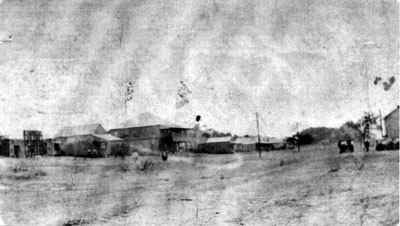 |
| Here is "downtown" Mungana today. A surprising amount of debris attests to the former human occupation, mostly covered by a combination of china apple trees and rubber vines. China apples (for those who don't know) have nasty reversed spikes that grip the skin and usually leave large numbers of fine shallow scratches, just the thing on a hot day with 1,000,000 flies. The rubber vine is equally nasty. It's party trick is that it is so entangling that you have to break it or cut it to get through it, it is impossible to simply push through. The sap, if it gets into your eyes, will cause instant, painful and irreversible blindness. I make a point of wearing close fitting sunglasses anywhere near the evil stuff. | 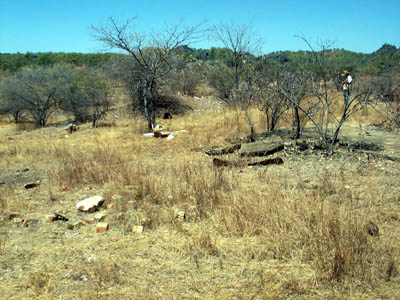 |
| This is a general view of the site we surveyed. There is some divergence of opinion within the group, but I believe that this is the remains of the town's butcher shop. Rubber vines have begun breaking up the foundation slab and given a few more years they will complete the job. No doubt they will be assisted by "visitors" who will develop a sudden curiosity about what could be underneath a concrete slab and will have an uncontrollable urge to interfere further with it. |  |
| I am of course talking about the gormless
idiots who believed that this derelict stove posed such a threat to life
and limb that they first hitched it to a 4WD, towed it out into what was
a street and then shot it repeatedly with a .223 rifle just to make sure
it couldn't harm anyone else.
Left alone it was an excellent marker for the location of commercial premises (pub or cafe by the size of it) and was also a damm side more intact than it is now. There is a debris trail stretching back about 60 meters from where it was towed. |
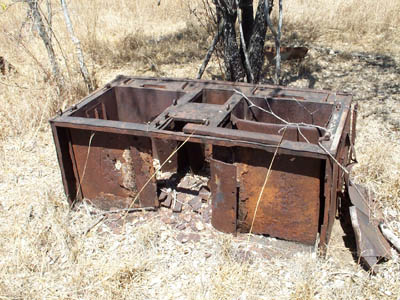 |
| Of less interest to the fearless hunters were the
numerous piles of "ready use" spares left by the railway
workers along the line. As I walked from Mungana to the Girofla mine I
noted several stacks of plates, bolts and even a complete spare points assembly.
The rail itself incidentally is all 60 pound stuff, so it is a little surprising
that it was left there. Generally rail of this quality is ripped up and
recycled elsewhere. There was some speculation amongst our group that it
had been left in case the red Dome mine just a little further down the
road ever need railway cartage. A forlorn hope as not only did Red Dome
always use road haulage, it too has now closed.
I might briefly mention that the Red Dome mine was about the only one in this district that ever turned an honest profit. The entire Chillagoe Mungana area is testament to over capitalized mining ventures in a declining market. One day I must take photos of the smelter site at Chillagoe as it was a spectacular financial sponge.
|
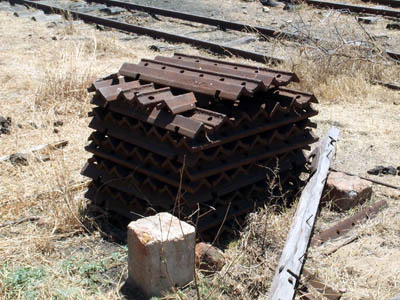 |
| I'm going to be a bit cagey as to where this
beauty actually is. Riveted together manual signals are now very much a
rarity and this would quickly end up in someone's private collection.
Bushfires have burned off the wooden signaling arm and a bright spark
has shot the lamp away, but it still actually works.
A tribute tot he railway engineers who designed the damm things. |
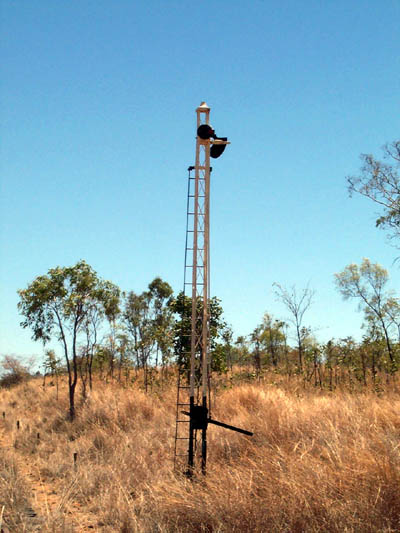 |
| At the time of this line's construction there was controversy between the private contractor who built the line and the Government Railways inspector over the use of local "round" timber instead of Government approved cut square sleepers. Given that after 90 odd years the majority of the sleepers are as good as the day they were laid down I think the contractor has posthumously won that argument. | 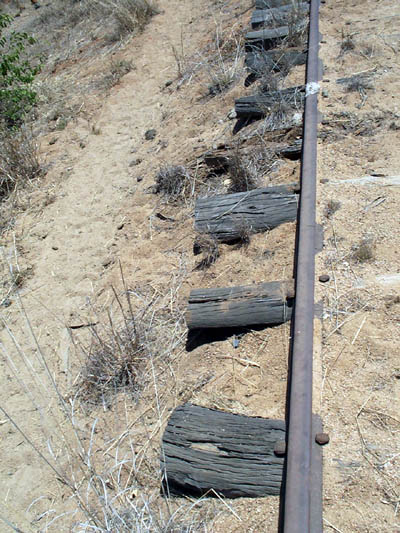 |
| This pump arm is the biggest relic left at the Girofla mine site. It was obviously too big to handle when the mine equipment was sold and in any case mine technology had moved on a bit. It sits on a 4 inch bearing shaft with babbet bearings cast in-situ. I'm pretty confident that hitched to an engine it would still work today. | 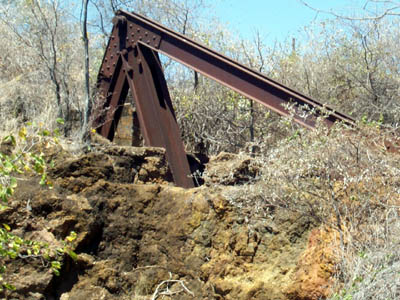 |
| This is the very narrow shaft that would have housed the pumps and associated piping. I could not see the bottom even with strong sunlight directly overhead. | 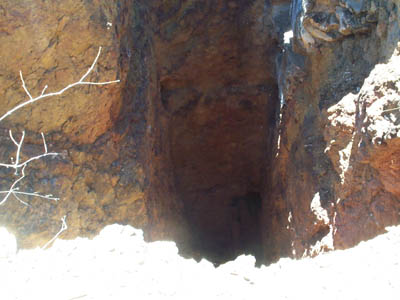 |
| Girofla started life as an open cut mine and then became a deep "hard rock" mine. I also suspect that it had major de-watering problems. On the eastern side of the site is a plethora of small machinery stands. Given the size of the foundations and the bits of remaining pipe work I believe that these are the remains of an ever increasing number of pumps that were needed to keep the mine dry as it went deeper. I counted the foundations of 15 smallish machinery stands. | 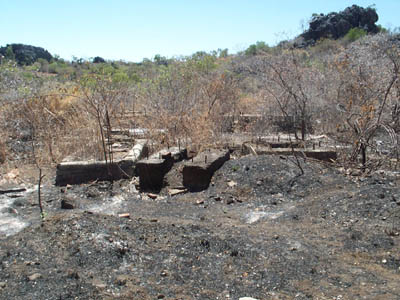 |
| Not all of it was small machinery though. There were a couple of big steam engines here, using studs set in the foundations. I was intrigued by these as they all have "dead centre" marks (not visible here due to the pen) which indicate that they were turned on a lathe. If it was a treadle lathe then it would have been bloody hard work making the hundred or so that were used to mount the big machines. | 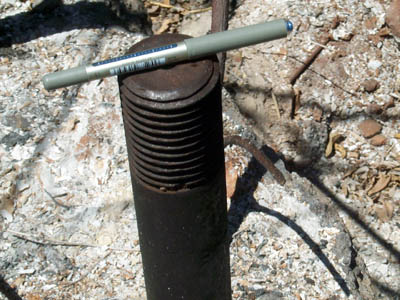 |
| A sure sign that when this mine closed the machinery was removed for scrap rather than sale. A number of the machines show signs of being "assisted" from their mounts with explosives. This one still shows the clean line of the drill used to bore the hole the explosive was placed in. It has also exposed part of the tin sleeve that surrounds all of the heavier mounting studs. It looks like the sleeves were filled with a thin mixture of better quality concrete than the remainder of the foundations which look fairly low quality and very cement poor to my eye. | 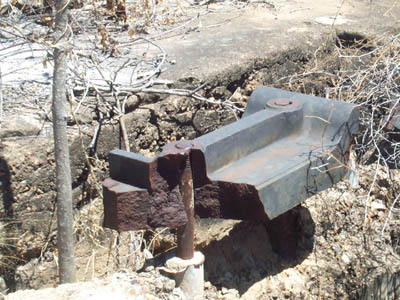 |
| This is the base of the mine's main smoke stack. There is a long flue running away to the left heavily encased in china apple and rubber vine. The bricks from the stack are scattered in a more or less circular pattern to a distance of 20 metres from the base, suggesting that the stack was blown down with explosive rather than succumbing to nature. | 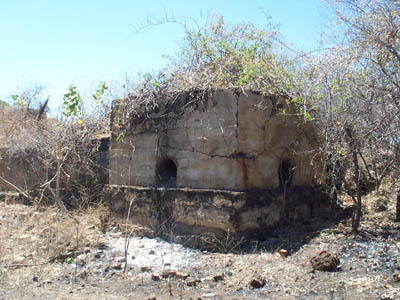 |
| Across from the main stack on a small peak is this base of what I think was a water tank. I suspect that this was the clean water tank for drinking and steam raising as it has been placed up high to gravity feed to virtually any location on the site. | 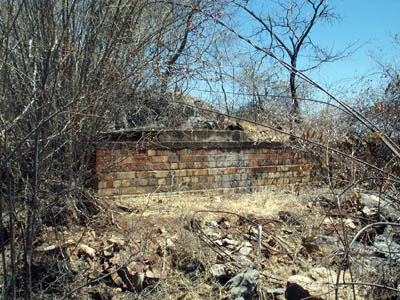 |
| Some distance from both the town site and the
mines is the Mungana cemetery. Like many small town cemeteries
there are some elaborate markers like this one, some less elaborate and
others marked with long illegible steel plate or sometimes simply
nothing at all.
A significant number of graves at around the same date and predominately children is I suspect mute testament to a local influenza outbreak. |
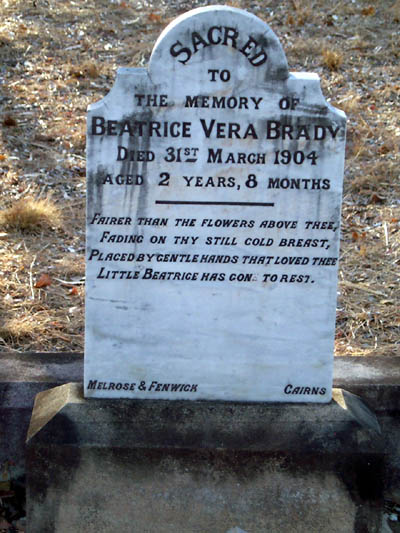 |
| Near the cemetery and in stark contrast to
the rest of the Mungana district is a heavily signposted
"aboriginal cave painting" site. I am told that there are very
significant paint sites in the district, but I don't think this is one
of them. On close examination I suspect this to be the work of the
Walpamur tribe.
Still if it keeps real paintings safe, I'm for it. |
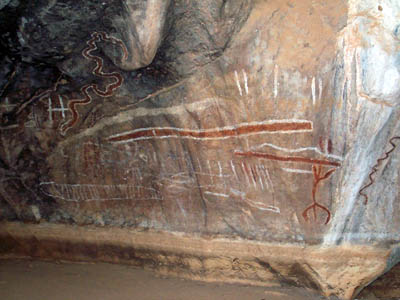 |
